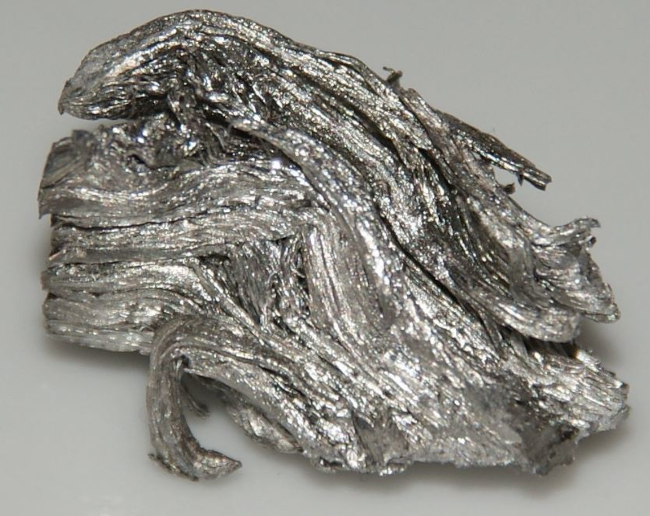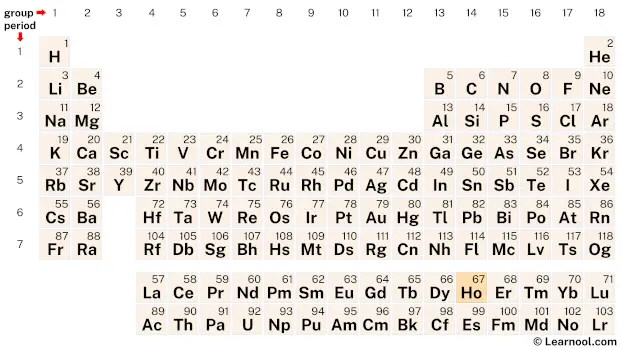
Holmium (Ho) is a chemical element of the periodic table, located in the period 6, and has the atomic number 67. It is the eleventh element in the lanthanide series. It is a soft, malleable, silvery-white metal, whose name comes from “Holmia”, Latin name for the city of Stockholm. It is a highly reactive metal and is counted as one of the rare earth elements.
On periodic table
| group | ⇨ | 1 | 2 | 3 | 4 | 5 | 6 | 7 | 8 | 9 | 10 | 11 | 12 | 13 | 14 | 15 | 16 | 17 | 18 |
| period | ⇩ | ||||||||||||||||||
| 1 | 1 H  Hydrogen |
2 He  Helium |
|||||||||||||||||
| 2 | 3 Li  Lithium |
4 Be  Beryllium |
5 B  Boron |
6 C  Carbon |
7 N  Nitrogen |
8 O  Oxygen |
9 F  Fluorine |
10 Ne  Neon |
|||||||||||
| 3 | 11 Na  Sodium |
12 Mg  Magnesium |
13 Al  Aluminium |
14 Si Silicon |
15 P  Phosphorus |
16 S  Sulfur |
17 Cl  Chlorine |
18 Ar  Argon |
|||||||||||
| 4 | 19 K  Potassium |
20 Ca  Calcium |
21 Sc  Scandium |
22 Ti  Titanium |
23 V  Vanadium |
24 Cr  Chromium |
25 Mn  Manganese |
26 Fe  Iron |
27 Co  Cobalt |
28 Ni  Nickel |
29 Cu  Copper |
30 Zn  Zinc |
31 Ga  Gallium |
32 Ge  Germanium |
33 As  Arsenic |
34 Se  Selenium |
35 Br  Bromine |
36 Kr  Krypton |
|
| 5 | 37 Rb  Rubidium |
38 Sr  Strontium |
39 Y  Yttrium |
40 Zr  Zirconium |
41 Nb  Niobium |
42 Mo  Molybdenum |
43 Tc  Technetium |
44 Ru  Ruthenium |
45 Rh  Rhodium |
46 Pd  Palladium |
47 Ag  Silver |
48 Cd  Cadmium |
49 In  Indium |
50 Sn  Tin |
51 Sb  Antimony |
52 Te  Tellurium |
53 I  Iodine |
54 Xe  Xenon |
|
| 6 | 55 Cs  Caesium |
56 Ba  Barium |
72 Hf  Hafnium |
73 Ta  Tantalum |
74 W  Tungsten |
75 Re  Rhenium |
76 Os  Osmium |
77 Ir  Iridium |
78 Pt  Platinum |
79 Au  Gold |
80 Hg  Mercury |
81 Tl  Thallium |
82 Pb  Lead |
83 Bi  Bismuth |
84 Po  Polonium |
85 At  Astatine |
86 Rn  Radon |
||
| 7 | 87 Fr  Francium |
88 Ra  Radium |
104 Rf  Rutherfordium |
105 Db  Dubnium |
106 Sg  Seaborgium |
107 Bh  Bohrium |
108 Hs  Hassium |
109 Mt  Meitnerium |
110 Ds  Darmstadtium |
111 Rg  Roentgenium |
112 Cn  Copernicium |
113 Nh  Nihonium |
114 Fl  Flerovium |
115 Mc  Moscovium |
116 Lv  Livermorium |
117 Ts  Tennessine |
118 Og  Oganesson |
||
| 57 La  Lanthanum |
58 Ce  Cerium |
59 Pr  Praseodymium |
60 Nd  Neodymium |
61 Pm  Promethium |
62 Sm  Samarium |
63 Eu  Europium |
64 Gd  Gadolinium |
65 Tb  Terbium |
66 Dy  Dysprosium |
67 Ho Holmium |
68 Er  Erbium |
69 Tm  Thulium |
70 Yb  Ytterbium |
71 Lu  Lutetium |
|||||
| 89 Ac  Actinium |
90 Th  Thorium |
91 Pa  Protactinium |
92 U  Uranium |
93 Np  Neptunium |
94 Pu  Plutonium |
95 Am  Americium |
96 Cm  Curium |
97 Bk  Berkelium |
98 Cf  Californium |
99 Es  Einsteinium |
100 Fm  Fermium |
101 Md  Mendelevium |
102 No  Nobelium |
103 Lr  Lawrencium |
|||||
| – f block |
Holmium is a member of the lanthanide series, a group of elements located at the bottom of the periodic table. It can be found in period 6, between dysprosium (Dy) and erbium (Er).
Element information
 |
|
 |
|
| Origin of name | name comes from Holmia, Latin name for Stockholm |
| Symbol | Ho |
| Atomic number (Z) | 67 |
| Atomic mass | 164.93032 u |
| Block | f-block |
| Period | 6 |
| Classification | Lanthanide |
| Atomic radius | 176 pm |
| Covalent radius | 192±7 pm |
| Melting point | 1461 ℃, 2662 ℉, 1734 K |
| Boiling point | 2600 ℃, 4712 ℉, 2873 K |
| Electron configuration | [Xe] 4f11 6s2 |
| Learn how to write: Holmium electron configuration | |
| Electrons per shell | 2, 8, 18, 29, 8, 2 |
| Crystal structure | Hexagonal close-packed (hcp) |
| Phase at r.t | Solid |
| Density near r.t | 8.79 g/cm3 |
| Main isotopes | Holmium-165 |
| Natural occurrence | Primordial |
| Oxidation state | +3 |
| Electronegativity (Pauling scale) | 1.23 |
| Protons Neutrons Electrons |
67 98 67 |
| CAS number | 7440-60-0 |
| Discovered by | Jacques-Louis Soret and Marc Delafontaine in 1878 |
History
Holmium was discovered in 1878 by Swiss chemists Marc Delafontaine and Jacques-Louis Soret, who observed spectral lines in the mineral erbia. They named the element after Holmia, the Latin name for Stockholm, Sweden, where they found the mineral. The discovery of holmium was part of a larger effort to isolate rare earth elements, which were becoming increasingly important in the late 19th century for their unique chemical and physical properties.
After its discovery, holmium was initially used primarily for scientific research, particularly in the fields of spectroscopy and magnetism. However, in the 20th century, new applications were found for the element, including its use as a control rod material in nuclear reactors due to its high neutron-absorbing ability. Today, holmium is still primarily used for scientific research and as a component in high-tech applications such as lasers and microwave equipment.
Occurrence and production
Holmium is a rare-earth element that is found in small amounts in several minerals such as gadolinite, monazite, and xenotime. It is estimated that the abundance of holmium in the earth’s crust is about 1.4 ppm. Due to its rarity, holmium is considered one of the most expensive rare-earth elements.
Holmium is primarily produced through ion exchange or solvent extraction methods from monazite sand. Monazite is a naturally occurring mineral that contains high levels of rare-earth elements. The process involves treating the monazite with sulfuric acid to produce a sulfate solution, which is then purified and further processed to isolate holmium. Holmium can also be produced through the reduction of its anhydrous chloride with metallic calcium.
Properties
Holmium is a silvery-white, soft and ductile metal.
It has high magnetic susceptibility and an unusually large magnetic moment.
Holmium is one of the most paramagnetic substances known, meaning it is strongly affected by magnetic fields.
It has a relatively high melting point of 1461 ℃ and boiling point of 2600 ℃.
Holmium has the highest magnetic moment of any naturally occurring element and is used in magnetic alloys and in certain metallic alloys.
It is also notable for its strong absorption of neutrons, making it useful in nuclear reactors.
Holmium also exhibits a characteristic pink coloration in some of its compounds.
Applications
Nuclear reactors
Holmium is used as a control material in nuclear reactors due to its high neutron absorption cross-section. It helps in controlling the rate of nuclear fission and maintaining the stability of the reactor.
Magnetic resonance imaging (MRI)
Holmium is used in the production of contrast agents for MRI scans. When holmium is complexed with a chelating agent, it can be used as a contrast agent for imaging soft tissues in the human body.
Lasers
Holmium-doped lasers are used in a variety of applications, including surgical procedures, industrial cutting and welding, and scientific research. Holmium lasers have a wavelength of 2.1 microns, which makes them ideal for cutting and welding materials that are difficult to cut with other types of lasers.
Glass and ceramic coloring
Holmium oxide is used as a coloring agent for glass and ceramics, producing a range of colors from yellow to red.
Magnets
Holmium is used in the production of high-strength magnets for use in the aerospace, automotive, and electronics industries. When combined with other rare earth metals, holmium can create magnets with magnetic fields stronger than those of traditional magnets.
Catalysis
Holmium compounds are used as catalysts in a variety of chemical reactions, including hydrogenation, hydrocracking, and isomerization.
Scientific research
Holmium is used in scientific research to study the magnetic and electronic properties of materials. Its unique magnetic properties make it a useful tool for studying the behavior of electrons in solid-state materials.
Interesting facts
Holmium is named after Stockholm, the city where it was discovered by Swiss chemists Marc Delafontaine and Jacques-Louis Soret in 1878.
Holmium is a rare-earth metal that is silver-gray in appearance and highly magnetic. It has a high melting point and is very ductile and malleable.
One of the most interesting properties of holmium is its ability to absorb and emit light in the near-infrared range. This property makes it useful in a variety of applications, including fiber-optic communication, laser technology, and medical imaging.
Holmium has the highest magnetic moment of any naturally occurring element, which makes it useful in magnetic resonance imaging (MRI) technology.
Holmium is also used in nuclear reactors as a neutron absorber and in nuclear medicine to treat some types of cancer.
Holmium is not found in nature as a free element, but is typically extracted from other rare-earth minerals through a complex process involving multiple steps.
Holmium is a relatively expensive element, with a market price of around $1,000 per kilogram.
Related
More elements
External links
- https://www.rsc.org/periodic-table/element/67/holmium
- https://en.wikipedia.org/wiki/Holmium
- https://www.britannica.com/science/holmium
- https://www.chemicool.com/elements/holmium.html
- https://pubchem.ncbi.nlm.nih.gov/element/Holmium
- https://www.utoledo.edu/nsm/ic/elements/holmium.html
- https://study.com/learn/lesson/holmium-element-in-periodic-table-symbol-facts-uses.html
- https://www.encyclopedia.com/science-and-technology/chemistry/compounds-and-elements/holmium
Deep
Learnool.com was founded by Deep Rana, who is a mechanical engineer by profession and a blogger by passion. He has a good conceptual knowledge on different educational topics and he provides the same on this website. He loves to learn something new everyday and believes that the best utilization of free time is developing a new skill.
